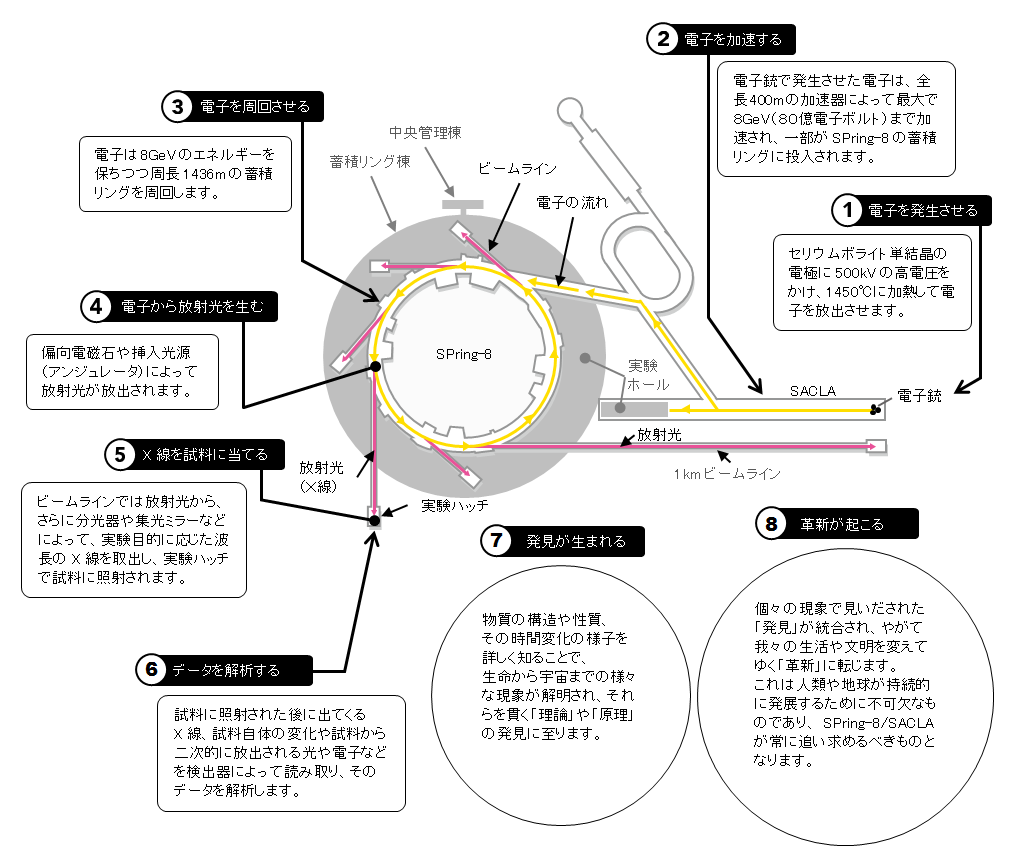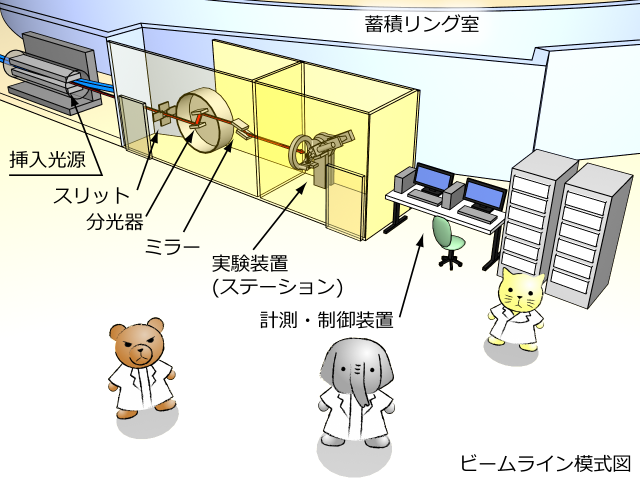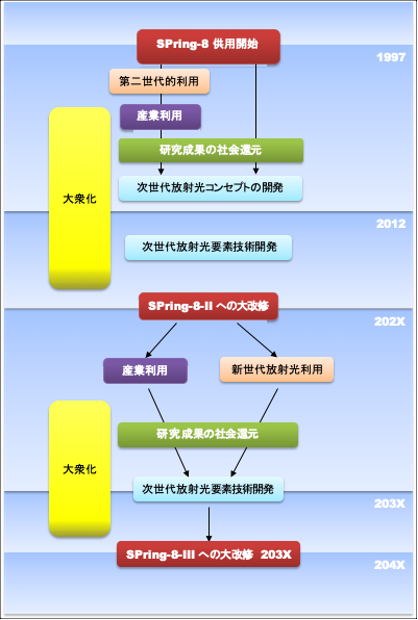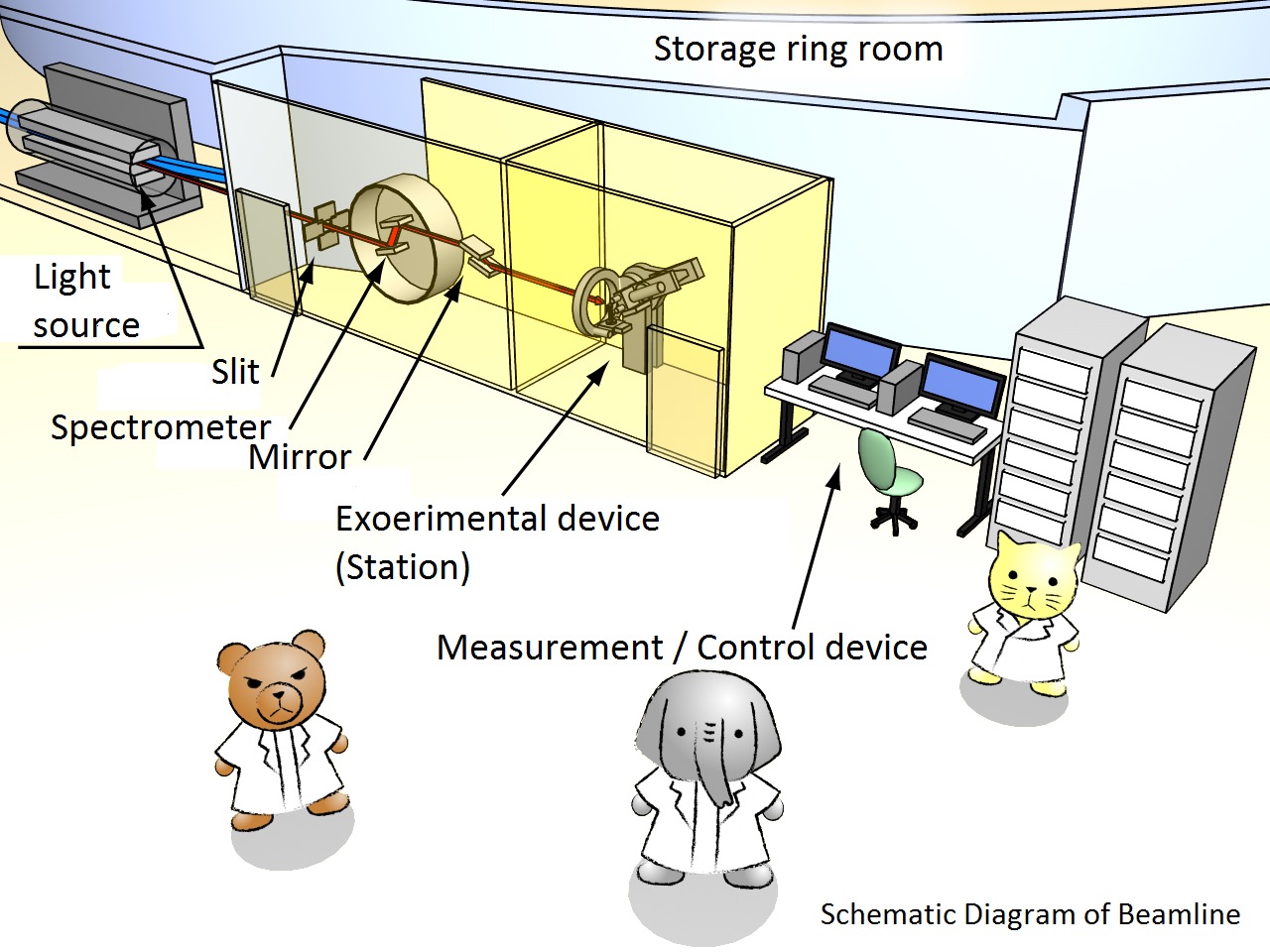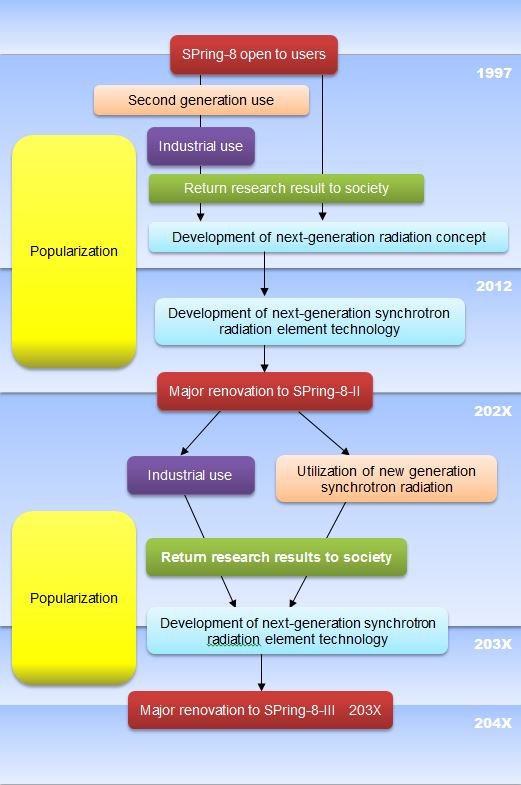SPring-8とは
| 歴史 | 放射光 | 仕組み | ビームライン | 将来 |

兵庫県の播磨科学公園都市にある世界最高性能の放射光を生み出すことができる大型放射光施設です。SPring-8では放射光を用いてナノテクノロジーやバイオテクノロジー、産業利用まで幅広い研究を行っており、その名前はSuper Photon SPring-8 GeV(80億電子ボルト)に由来しています。SPring-8は国内外の産学官の研究者等に開かれた共同利用施設であり、1997年より放射光を大学や公的研究機関や企業等のユーザーに提供しています。課題申請などの手続きを行い、採択されれば、誰でも利用することができます。SPring-8の運営は施設者である 国立研究開発法人理化学研究所が行い、SPring-8の利用者選定業務及び利用者支援業務(利用促進業務)を 公益財団法人高輝度光科学研究センターが行っています。
SPring-8の歴史

| 1997年10月 | 10本のビームラインで供用を開始 |
| 1999年 2月 | 全長200mのビームライン稼働 |
| 2000年 5月 | 赤外線用ビームライン、全長1kmのビームラインが稼働(6月) |
| 2007年 9月 | 産業利用ビームライン26本が稼働 |
| 2008年4月 | 次期高度化計画の検討開始(SPring-8とSACLAの相乗効果含む) |
| 2009年10月 | 東京大学のビームラインが稼働 |
| 2011年 6月 | X線自由電子レーザー施設(SACLA)発振 |
| 2012年 3月 | SACLA供用開始 |
| 2012年4月 | 加速器運転設備の老朽化対策・改修を開始 |
| 2013年10月 | 全ビームライン57本が稼働(研究機関・企業利用向け26本、理研運用12本、研究機関・企業専有19本) |
| 2017年10月 | 供用開始20年の記念式典開催(20年間で延べ約20万人以上が利用) |
SPring-8の放射光
放射光とは、電子が磁場(磁石)で曲げられるときにその進行方向に放射される光のことです。SPring-8がつくる放射光は電子のエネルギーが高く明るい光になり、波長が短く、より透過力の強いX線を含みます。細く絞り込まれていて輝度も高いためミクロレベルより小さな領域をより明るく照らすことが出来ます。
SPring-8で放射光がつくられる仕組み
SPring-8は、電子を発生させる電子銃、電子を加速するための加速器、そして電子ビームをためておくための蓄積リングで構成されています。一連の動作としては、SACLAの電子銃①から打ち出された電子を加速器②によって8GeV(80億電子ボルト)まで加速し、外周約1,500mの蓄積リング③に投入、周回させて、偏向電磁石や挿入光源④により放射光を発生させます。発生した放射光(X線)は、ビームラインを通して蓄積リング内外に設けられた実験ハッチ⑤に導かれ、さまざまな実験に利用されます。
ビームラインとは

ビームラインとは、蓄積リングの外側に配置され、放射光を実験装置(ステーション)に導くとともに、その途中で、幅広いスペクトルの放射光を分光器で特定の波長(エネルギー)に単色化しビームの広がりを整形する一種の導波路です。また、ステーションでの作業を安全に行うために、放射光を途中で遮断するインターロックやシャッターや、高速ゲートバルブなどが途中に配置されます。
SPring-8の将来
SPring-8は1997年に、SACLAは2012年に供用を開始しました。SPring-8は建設後ほぼ20年が最先端施設としての寿命と考えられ、世界で第一線級の施設であり続けるためには、2020年代中のSPring-8-Ⅱへの大改修は避けて通れません。SACLAもいずれ大改修が必要となります。SPring-8-Ⅱの大改修から20年後に予想されるSPring-8-Ⅲでは、リング型のX線自由電子レーザー施設が実現しているかもしれません。
What is SPring-8?

SPring-8 is a large synchrotron radiation facility, located at the Harima Science Garden City in Hyogo, having the world’s highest performance. SPring-8 has a wide range of research capabilities used for nanotechnology, biotechnology, and even industrial products. The name SPring-8 derives from the “Super Photon Ring-8 GeV” (8 billion electron volts).
SPring-8 is a joint-operated facility open to researchers from industry, science and government in Japan and overseas. Since 1997, synchrotron radiation has been provided to universities, public research institutes and companies through application and screening processes.
SPring-8 is operated by RIKEN, while it’s user selection, support and promotion are managed by the Japan Synchrotron Radiation Research Institute (JASRI).
SPring-8, 20 years of History

| October 1997 | Service began with 10 beamlines. |
| February 1999 | The 200m beamline became operational. |
| May 2000 | The infrared beamline and 1km beamline (June) became operational. |
| September 2007 | 26 Industrial Beamlines were in service. |
| April 2008 | Upgrade planning began (including synergistic plans for SPring-8 and SACLA). |
| October 2009 | The University of Tokyo’s beamline became operational. |
| June 2011 | The X-ray free electron laser facility became operational (SACLA). |
| March 2012 | SACLA opened for service. |
| April 2012 | Began repairs and restorations on aging accelerator equipment. |
| October 2013 | A total of 57 beams became operational (26 public, 12 RIKEN and 19 contract) |
| October 2017 | A ceremony was held to commemorate the 20th anniversary to the start of service (with over 200,000 users throughout that time) |
Synchrotron Radiation of SPring-8
Synchrotron radiation is emitted from electrons when their direction of motion is bent by magnetic fields. The synchrotron radiation created by high energy electrons contains X-rays with shorter wavelengths, having stronger transmission. Due to the narrow focused, high brightness beam, it is possible to illuminate smaller areas below the micro level.
Mechanisms of Synchrotron Radiation with SPring-8
SPring-8/SACLA consist of an electron gun to generate electrons, accelerators to accelerate electrons, and a storage ring to store the electrons for the electron beams.
The sequence of operations of SPring-8 include: The electrons launched from the SACLA electron gun ① are accelerated to the energy of 8GeV (8 Billion electron volts) by the accelerators ②. The electrons are then sent to the storage ring ③ which has a circumference of approximately 1500m. Bending magnets and insertion devices ④ deflect the electron trajectory, generating synchrotron radiation.
The generated X-rays from the synchrotron radiation are guided through the beamline to the experiment hutch ⑤, which is provided inside and outside the storage ring, and used for various experiments.
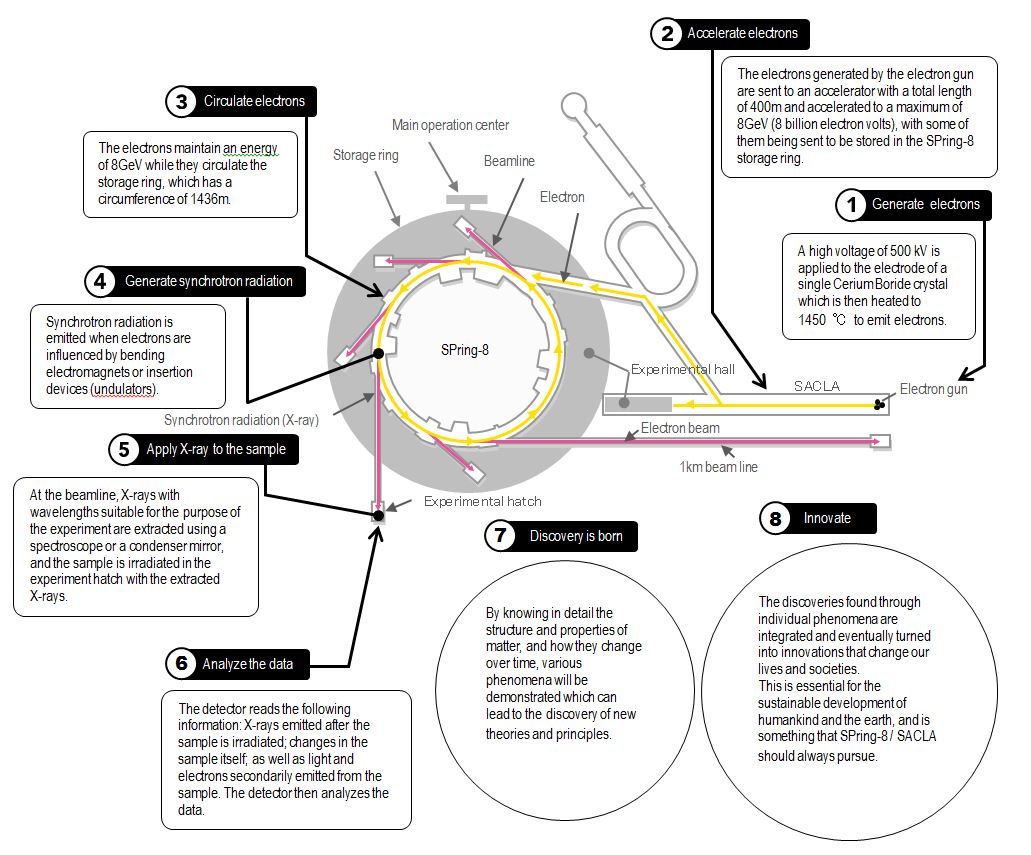
What is a Beamline?

The Future of SPring-8

